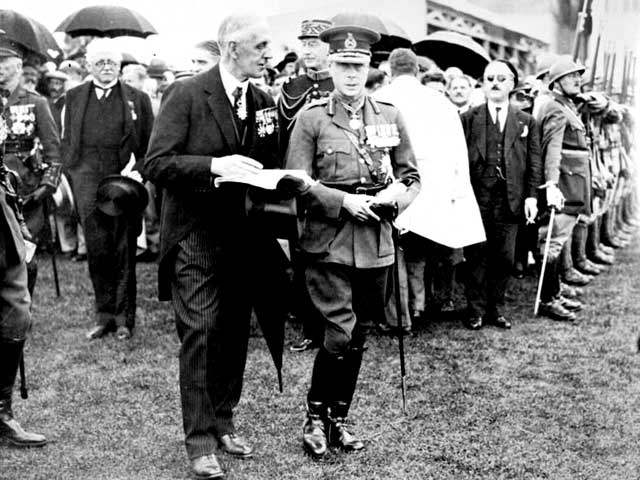Sir Fabian Ware speaking with the Prince of Wales. The prince urged Ware to raise his ideas for a war graves commission to the Imperial Conference.
The lives lost during the Great War surely received the proper tribute that they deserve. But, after the war, those who were determined to faced disagreements.
Resident historian at Galloway Travel Mike Peters, tells an account of resolute determination and Rudyard Kipling is a part of the story.
The Commonwealth War Graves Commission and its founding father, Fabian Ware were given a rebirth last week. He certainly did not have an easy time in his pursuit to pay tribute to the dead for some would simply have wanted to forget about the conflict. Ware met an influential ally in the Prince of Wales and made a lot of improvements before the end of the war.
Ware was persuaded by the prince to present a proposition for post- war administration of war graves to the Imperial War Conference on May 1917. His vision was approved by the delegates from across the British Empire for what was initially The Imperial War Graves Commission or IWGC. It was established by the Prince of Wales who himself was a veteran of the Western Front taking a leading role as the first president with Ware being the vice- president.
Years right after the war, the timing was still not the best time to consider a project of a large scale. The cost proposed by Ware and those who were in favor of him was simply huge. Britain was also weary and tired of the war. And a considerable and outspoken marginalized group had no inclination of supporting Ware’s vision and commemoration.
The intention for a great commemoration earned disapproval and was viewed as pointless and unjustifiably luxurious by some including poet Siegried Sassoon who regarded it as a glorification of war. Unworried by the criticisms and lifted by the help of vast majority of people in Britain and the Commonwealth, the commission pursued the project with vigor.
Adding to its energy is the support of the Prince of Wales and the Royal Charter. The commission set the highest standards stressing the need that cemeteries and memorials should be worthy of the sacrifice they commemorated.
The original ideas of Ware were very stylish. He wanted those who visited the tomb and memorials to find pleasurable space where they felt the serenity of their loved ones. Sir Edwin Lutyens Sir Herbert Baker, and Sir Reginald Blomfield, three of Britain’s most renowned architects, were invited to work on the project.
The materials to be used for the memorial graves were not just bricks and mortar. Horticulturist and gardeners who were foremost in the design process were also involved.
Rudyard Kipling, the poet of the empire was tasked for the selection of inscriptions for memorials and headstones as it was also given great importance. Kipling, himself, was then experiencing deep distress due to the loss of son, Jack, in 1915 during the Loos combat. The body of Jack was never recovered adding to his demise. Grief-stricken Kipling and his wife helped ensured that the Commission’s project had the inscriptions the fallen heroes of the Great War well-deserved.
In 1921, the Commission put up three experimental cemeteries with the recognition and retrieval of the corpse still going on around the globe. Considered as flourishing was the cemetery Forceville in France.
Gertrude Jekyll, a garden designer advised on the tree planting with architects creating a walled cemetery with standardized tombstone in an English garden setting. The formal features were the Cross of Sacrifice and Stone of Remembrance which were designed by Blomfield and Lutyen respectively. Forciville became the model after some modification.
An astounding 2,400 cemeteries were put up over the next decade in France and Belgium while in Italy, Egypt, Palestine, Macedonia, Mesopotamia [Iraq] and on the Gallipoli Peninsula [Turkey]. Memorials to the Missing were also made equally significant.
Among the memorials is the superb memorial in Ypres done by Blomfield, the Menin Gate Memorial which memorializes the names of more than 55,000 men on 1,200 plates. Other commemorative plaques were also set up after.
Tiny Cot in Belgium designed by Sir Herbert Baker, the Helles Memorial on Gallipoli designed by Sir John Burnet, the Thiepval Memorial on the Somme designed by Sir Edwin Lutyens were also among the famous memorials. Meanwhile, the missing in Salonika were commemorated at Lake Doiran on a monument by Sir Robert Lorimer.
The Canadians at Vimy Ridge, the Australians at Villers Bretonneux, and the South Africans at Delville Woods were also constructed afterwards. Menin Gate was also established on July 1927.
Thousands graced with their presence in the ceremony including the specially-invited war widows. Field Marshall Lord Plumer applied a few simple words to summarize what the Commission’s work was all about, “He is not missing, he is here.”
